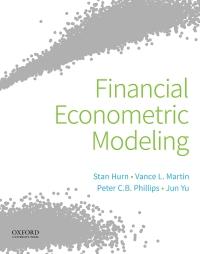The present value model predicts the following relationship between the two series [ p_{t}=beta_{0}+beta_{1} d_{t}+u_{t} ] where
Question:
The present value model predicts the following relationship between the two series
\[ p_{t}=\beta_{0}+\beta_{1} d_{t}+u_{t} \]
where \(p_{t}\) is the natural logarithm of real price of equities, \(d_{t}\) is the natural logarithm of real dividend payments, \(u_{t}\) is a disturbance term and \(\beta_{1}\) is the discount rate and \(\beta_{1}=1\).
(a) Test for cointegration between \(p_{t}\) and \(d_{t}\) using Model 3 and \(p=1\) lags.
(b) Given the results in part (a) estimate a bivariate ECM for \(p_{t}\) and \(d_{t}\) using Model 3 with \(p=1\) lag. Interpret the results paying particular attention to the long-run parameter estimates, \(\beta_{0}\) and \(\beta_{1}\) and the error correction parameter estimates, \(\widehat{\alpha}_{i}\).
(c) Derive an estimate of the long-run real discount rate from \(R=\) \(\exp \left(-\beta_{0}\right)\) and interpret the result.
(d) Test the restriction \(H_{0}: \beta_{1}=1\).
(e) Discuss whether the empirical results support the present value model.
Step by Step Answer:

Financial Econometric Modeling
ISBN: 9781633844605
1st Edition
Authors: Stan Hurn, Vance L. Martin, Jun Yu, Peter C.B. Phillips





